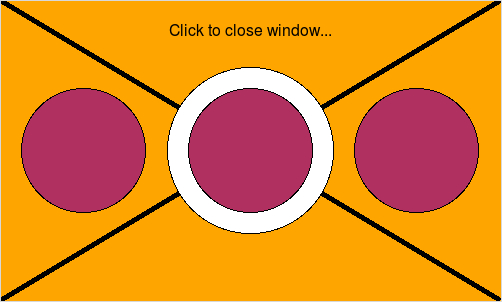WEEK05: computer graphics, using objects
---------------------------------------------------------------
M: what is an object? simple computer graphics
LAB 4: due Saturday
QUIZ 2 this Wednesday
REVIEW from last week: str methods
>>> help(str)
>>>
>>> S = "we love computer science"
>>> S.upper()
'WE LOVE COMPUTER SCIENCE'
>>> S.capitalize()
'We love computer science'
>>> print S
we love computer science
(upper() and many str methods DON'T CHANGE the string S!!!)
>>> S.split()
['we', 'love', 'computer', 'science']
>>> S.count("e")
5
>>> S.index("w")
0
there are many useful str methods!!!
OBJECTS AND OOP (Object-Oriented Programming)
- data types we've seen so far: int, float, string, boolean
- each has certain kinds of data/values and operations
- functions we've seen so far: type(5), len("hello"), range(10)
- objects combine data and functions (methods) into one thing
RADIO EXAMPLE:
- for a real radio, you can turn it on/off, change the
volume, change the station
- if you wrote a program to act like a radio (like Pandora)
you would want similar features:
myradio = Radio() <--- constructor creates object
with initial data and methods
- use dot operator to change the object data
(manipulate the object)
myradio.setVolume(10)
myradio.setStation(91.5)
anotherradio = Radio()
anotherradio.setStation(90.1)
==> call object methods to change the object
SUDOKU EXAMPLE:
puzzle = [9,0,7,5,6,0...]
row1 = puzzle[0:9]
col1 = puzzle[0:81:9]
- can write sudoku program using above, OR we can create
a Sudoku object that has getRow() and getCol() methods:
puzzle = Sudoku([9,0,7,5,6,0...])
row1 = puzzle.getRow(1)
col1 = puzzle.getCol(1)
- using objects and methods: OBJECT.METHOD()
COMPUTER GRAPHICS:
- we are using the graphics module from the Zelle book
from graphics import *
- in the graphics window, x increases to the right, y increases
down, so the point 0,0 is the top left corner
0,0 ------> x 500,0
|
|
|
V
y
0,300 500,300
- try some simple objects: GraphWin, Point, Line, Circle:
>>> from graphics import *
>>> w = GraphWin()
>>> p = Point(50,90)
>>> p.draw(w)
>>> c = Circle(p, 20)
>>> c.setFill("red")
>>> c.draw(w)
OBJECT-ORIENTED PROGRAMMING
- build complex systems out of simple objects
- more intuitive (circle object, fill, draw), objects in code
correspond to real-world objects
- reusability (design objects that can be used in other programs)
- we'll design and create our own objects later this semester
YOUR TURN
- see if you can write a program to make this image:

